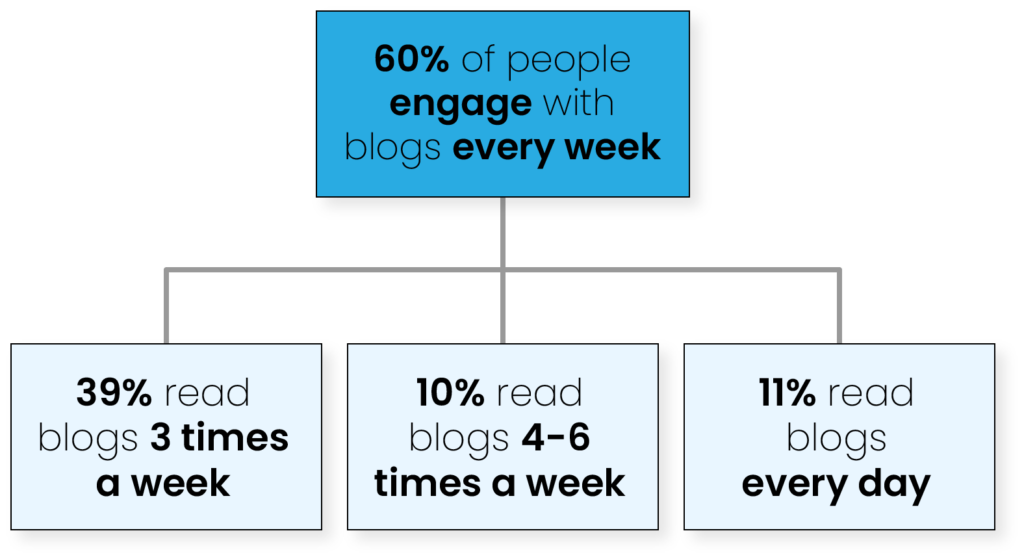Connect
Connection is key for business success in 2024 and blogging is the content strategy that provides that first valuable hello. Giving customers the ability to connect with your business on their time frame, blogs are the informative helping hand that connects solutions to problems. Connect, and find your audience with a bespoke blog.
Your audience engages with blogs
Your customers are online, waiting to connect through a blog. The numbers simply don’t lie. Blogging is engaging customers all over the world in large numbers, adding value to businesses and consumers alike, and the stats show it:
Statistic 1: 4.28 billion people online interact with blogs
5.35 billion people, out of 8 billion people worldwide, use the internet. Demand metric find that, in 2024, 80% of the people using the internet interact with blogs and social media. That’s 4.28 billion people interacting with blog posts, a statistic that WordPress, one content hosting company, seem to support.
Statistic 2: 409 million people view 20 billion blog pages, hosted by WordPress, every month
WordPress share ‘live look’ stats showing that 409 million people globally view more than 20 billion blog pages, every month. People engage with blogs:
- Every week, over 5 billion WordPress blogs are viewed.
- That’s over 714, 285, 714.3 million WordPress blog views a day.
- A huge 29,796,904.8 million WordPress blog views an hour.
This set of statistics highlights the phenomenal reach and engagement potential a blog has in 2024. What’s more, WordPress are not the only blog hosting site on the web, so blog engagement figures globally will be even higher. The blog is a wide-reaching form of content people like, interact with, and consume.
Statistic 3: Blogs capture attention from all ages
Blogs appeal to people of all ages. Statista have data demonstrating that nearly 26% of children aged 5 – 18 years old read blogs. In the USA, statistics have shown that 42.23% of people in the USA between the ages of 18 and 49 read blogs. With universal appeal, blogs can be tailored to meet audience needs, providing connection and communication across all age ranges.
Blogs have reach and your customers are out there. If your business is not communicating using a blog in 2024 you are missing a valuable opportunity to find customers. Blogs are powerful communication tools, providing people with valuable insight and information they want. A blog is not about selling; it’s about communicating.
Communicate
People don’t want to have businesses popping up with overt sales pitches in 2024. They want authentic communication that meets their needs at a time they want to consume information. Blogging adds this value to your content strategy, by meeting customer expectations, and providing information to aid decision making.
Expectations
There is a consumer expectation that businesses will have an online presence customers can engage with in 2024. If people can’t find a business to make a connection with, it arouses suspicion. The trend of online communication is growing in line with customer expectations.
Statistic 4: Business blogs grew by 56% in 5 years
Statistics provided by Statista demonstrate a 56% growth rate in the number of Fortune 500 companies adopting blogs between 2015 and 2020, a number that has continued to grow. In 2015 21% of Fortune 500 companies had a blog; in 2020 that jumped to 77%. Highlighting a change in customer buying psychology, blogging is increasing so businesses can communicate with potential customer’s at the first stage of their buying journey.
Statistic 5: 81% of retail shoppers research online
According to a statistic published by GE Capital Retail Bank, a huge 81% of people will not buy without researching online. The information they peruse will likely cover cost of product, quality of product, and other people’s experiences with the product.
Statistic 6: 44% of people read 3 to 5 informative pieces before buying
Backing up the research of GE Capital Bank, Techreport say that in 2024, 44% of consumers will normally read three to five pieces of information about a product before making a purchasing decision. Consuming blogs forms part of that research journey.
Statistic 7: 70% of people like to read blogs
Demand Metric have found learning through long form content, like blogs, is the preferred choice for consumers. An informative blog that is engaging and communicates relevant information that is not sales based is valuable to the customer on their buying journey.
Statistic 8: 71% expect personalised communication
McKinsey & Company found 71% of people expect a brand to provide personalised communication, an expectation translating across both digital and print communications. In 2024, people expect businesses to communicate authentically and on a deeper, personal level. This expectation feeds highly into the decision-making process.
Decisions
Decisions are swayed by the opinions we consume. Blogs provide a source of opinion that communicates to customers and helps inform their buying decisions.
Statistic 9: 82% of customers feel positive after reading custom content
Demand Metric say 82% of customers who read custom content about businesses feel positive afterwards. Custom content, like blogs, helps to communicate with customers positively. Positive communication through reading custom content encourages more meaningful relationships with customers who build connections with values that business shares.
Statistic 10: 60% of people enjoy reading branded content
Techreport say: “Most people, about 60%, like reading stuff from their favourite brands”. There is a belief from consumers that businesses should have custom content for them to engage with. Many may wonder why you don’t, particularly if they are already a customer.
Statistic 11: 90% of people believe businesses need custom content
Techreport, who provide this statistic, highlight the expectation from customers who are willing and looking for branded content to engage with. This suggests that consumers build trust with brands through engagement with content. They want to connect.
Statistic 12: Nearly 50% of people are influenced by bloggers and vloggers
A statistic from Blogging Wizard finds that nearly half of all internet users value the opinion of bloggers and vloggers. Creating trust through authentic content, today’s consumer looks for confirmation of a product as part of their buying journey.
Statistic 13: A purpose increases engagement by 4 to 6 times
Forbes find that companies that companies who have a strong purpose, are more likely to have loyal customers who will promote and protect the business. Consumers today engage on a more meaningful level and blogging as a company provides the opportunity to showcase your purpose.

Statistic 14: 60% of the population engage with blogs 3 times a week
BKA Content reveal that 60% of the global population engage with at least one blog once a week. Breaking their statistic down even further we have created this diagram.
Blogging is about investing in communication with your customers. Invest in this form of communication because your customer expects you to know them, expects you to have an online presence, and expects to be able to engage with a brand before making decisions.
Customer connection and communication should be at the heart of your reasoning when building your content strategy, but as a business you need results to justify investing your time into blogging. Blogging adds value by converting the people you connect and communicate with into customers.
Convert
When blogs convert people into customers your business will see the change through measurable metrics that demonstrate the impact. Blogging adds value across multiple areas of your business.
Grow your website and your leads
Increasing website traffic, keeping your website updated to increase the likelihood of ranking well in search engines and increasing leads, blogging provides powerful returns.
Statistic 15: 55% increase in website visitors
Impact find that when businesses use blogs their website traffic increases by up to 55%. With more customers on your website you are raising brand awareness and increasing the chances of them engaging with other content or choosing to purchase. The longer they consume your content, the more engaged they become with your brand.
Statistic 16: 126% increase in lead growth
Highlighting your products and services through blogging has been found to get a 126% increase in lead growth according to Master Blogging. Sharing authentic consumer driven information generates customer response.
Statistic 17: B2B businesses generate 67% more leads
A 2024 statistic from demandsage shows that blogging generates 67% more leads every month for B2B businesses. Businesses who blog provide stakeholders with useful information informing decision-making processes in the early stages and helping your brand stand out from competitors. Capture stakeholder attention with a blog so they remember your business when they need your service.
Statistic 18: Blogging keeps websites active
BKA Content say that websites who publish blogs regularly find improvements in two key metrics:
- They have 434% more indexed pages and
- 97% more inbound links that those without.
Websites that are regularly posting content and have good structures are more likely to organically rank higher in search engine results.
Growth in website visitors, improvements in search engine rankings, and increases in sales leads add value to your business, but did you know that blogging is a value for money marketing tool too?
Value for money
Blogging is an investment in business storytelling that yields positive returns.
Statistic 19: Prioritising blogging gets a positive Return on Investment
Using blogging in your marketing strategy is highly likely to yield positive results. Fundera state that your Return on Investment (ROI) is 13 times more likely to be positive when you prioritise blogging as a content strategy.
Statistic 20: Blogging costs less than outbound marketing
Using inbound marketing techniques like blogging will cost your business less than using outbound marketing techniques. ImpactPlus find that inbound marketing costs 62% less per lead than outbound marketing. This is a huge saving when calculating the cost of acquiring new customers.
Conclusion
Customers should always be at the forefront of your mind when approaching blogging as a form of content creation. A blog should be full of meaningful content that is worth reading. If it was a conversation, it would add value to your day and leave you feeling positive. Connecting with people, communicating information of value and converting people into customers is the purpose of blogging. Statistics show customers value blogs and blogs provide businesses with value. Stop thinking of a blog as a black sheep to be set apart from the rest of the content flock and embrace its quirky power to add value to your business in 2024.




